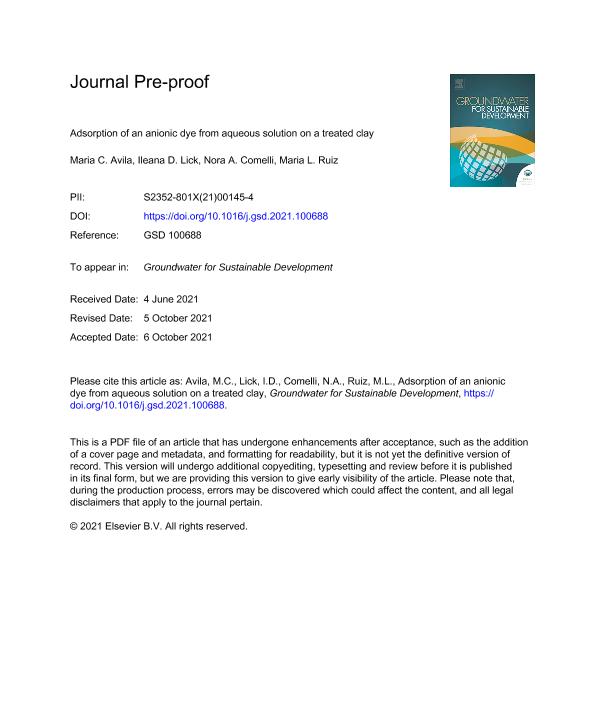Artículo
Adsorption of an anionic dye from aqueous solution on a treated clay
Fecha de publicación:
11/2021
Editorial:
Elsevier
Revista:
Groundwater for Sustainable Development
ISSN:
2352-801X
Idioma:
Inglés
Tipo de recurso:
Artículo publicado
Clasificación temática:
Resumen
The presence of synthetic dyes in water causes serious environmental issues dueto the poor water quality, toxicity to the environment and human carcinogenic effects.Adsorption has progressively become an economical and feasible method for dyewastewater decontamination. Clay minerals are an interesting alternative forremoving colorants from colored aqueous solutions because they are inexpensive,easy to extract and handle, and non-toxic. In this work, a bentonite treated withH2SO4 is used to adsorb an azoderivative dye such as methyl orange (MO). Thephysicochemical properties of the solids were evaluated through X-ray powderdiffraction (XRD), Brunauer Emmett Teller surface area analysis (BET), Scanningelectron microscopy coupled with Energy dispersive spectroscopy (SEM-EDS), andFourier transform infrared spectroscopy (FTIR). The initial dye concentration,adsorbent mass, contact time, temperature and pH influence the adsorptioncapacity. Acid modification of the clay increased its capacity to adsorb MO. For aconcentration of 200 mg/L MO, an adsorption capacity of 125 mg/g was achieved.The adsorption process follows the pseudo second-order kinetic model. Thethermodynamic study indicates that the adsorption is spontaneous and exothermic.The adsorption isotherm is best fitted to the Freundlich mathematical model. Theresults obtained show that, after receiving an acid treatment, clay can be effectivelyused to remove MO in aqueous solution.
Palabras clave:
ADSORPTION
,
CLAY
,
ANIONIC DYES
,
ISOTHERMS
Archivos asociados
Licencia
Identificadores
Colecciones
Articulos(CINDECA)
Articulos de CENTRO DE INV EN CS.APLICADAS "DR.JORGE J.RONCO"
Articulos de CENTRO DE INV EN CS.APLICADAS "DR.JORGE J.RONCO"
Articulos(INTEQUI)
Articulos de INST. DE INVEST. EN TECNOLOGIA QUIMICA
Articulos de INST. DE INVEST. EN TECNOLOGIA QUIMICA
Citación
Avila, Maria Cecilia; Lick, Ileana Daniela; Comelli, Nora Alejandra; Ruiz, Maria Lucia; Adsorption of an anionic dye from aqueous solution on a treated clay; Elsevier; Groundwater for Sustainable Development; 15; 11-2021; 1-49
Compartir
Altmétricas




